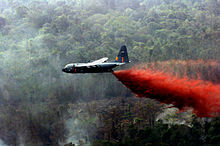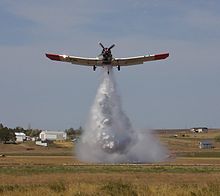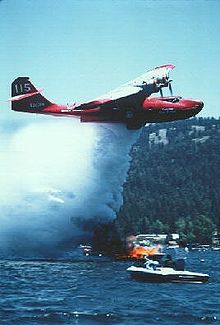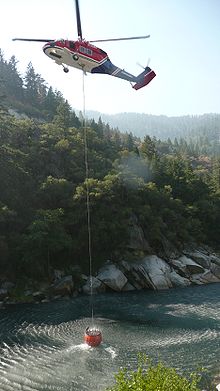- Aerial firefighting
-
"Airtanker" redirects here. For the British air-to-air refuelling project, see Future Strategic Tanker Aircraft.
Part of a series on
Wildland
Firefighting
Main articles Wildfire · Bushfires · Wildfire suppression
Tactics & Equipment Aerial firefighting · Controlled burn · Firebreak · Fire trail · Fire lookout tower · Fire-retardant gel · Fire fighting foam · Fire retardant · Helicopter bucket · Driptorch
Personnel Handcrew · Hotshots · Helitack · Smokejumper · Rappeller · Engine crew
Lists List of wildfires
Glossary of wildfire termsAerial firefighting is the use of aircraft and other aerial resources to combat wildfires. The types of aircraft used include fixed-wing aircraft and helicopters. Smokejumpers and rappellers are also classified as aerial firefighters, delivered to the fire by parachute from a variety of fixed-wing aircraft, or rappelling from helicopters. Chemicals used to fight fires may include water, water enhancers such as foams and gels, and specially formulated fire retardants.[1]
Contents
Terminology
A wide variety of terminology has been used in the popular media for the aircraft (and methods) used in aerial firefighting. The terms Airtanker or air tanker generally refer to fixed-wing aircraft based in the United States; "airtanker" is used in official documentation[2]. The term "waterbomber" is used in Canadian government documents for the same class of vehicles[3].[4]
Air attack is an industry term used for the actual application of aerial resources, both fixed-wing and rotorcraft, on a fire. Within the industry, though, "air attack" may also refer to the supervisor in the air (usually in a fixed-wing aircraft) who supervises the process of attacking the wildfire from the air, including fixed-wing airtankers, helicopters, and any other aviation resources assigned to the fire. The Air Tactical Group Supervisor (ATGS), often called "air attack," is usually flying at an altitude above other resources assigned to the fire, often in a fixed-wing plane but occasionally (depending on assigned resources or the availability of qualified personnel) in a helicopter.
Depending on the size, location, and assessed potential of the wildfire, the "air attack" or ATGS person may be charged with initial attack (the first response of firefighting assets on fire suppression), or with extended attack, the ongoing response to and management of a major wildfire requiring additional resources including engines, ground crews, and other aviation personnel and aircraft needed to control the fire and establish control lines or firelines ahead of the wildfire.[4]
Equipment
A wide variety of helicopters and fixed-wing aircraft are used for aerial firefighting. In 2003, it was reported that "The U.S. Forest Service and Bureau of Land Management own, lease, or contract for nearly 1,000 aircraft each fire season, with annual expenditures in excess of US$250 million in recent years".[5]
Helicopters
Helicopters may be fitted with tanks (helitankers) or they may carry buckets. Some helitankers, such as the Erickson AirCrane, are also outfitted with a front-mounted foam cannon. Buckets are usually filled by submerging or dipping them in lakes, rivers, reservoirs, or portable tanks. The most popular of the buckets is the flexible Bambi Bucket. Tanks can be filled on the ground (by water tenders or truck-mounted systems) or water can be siphoned from lakes, rivers, reservoirs, or a portable tank through a hanging snorkel. Popular firefighting helicopters include variants of the Bell 204 and the Erickson S-64 Aircrane helitanker, which features a sea snorkel for filling from a natural water source while in flight.
-
Mil Mi-8 of the Ukrainian Ministry of Emergency Situations taking on water near Nezhin
-
A Martin Mars bomber, one of the largest water bombers still flying in the world
-
Los Angeles County Fire Department's Sikorsky S-70C Firehawk during a water drop demonstration at Station 129 in Lancaster, California
Airtankers
Airtankers or water bombers are fixed-wing aircraft fitted with tanks that can be filled on the ground at an air tanker base or, in the case of flying boats and amphibious aircraft, by skimming water from lakes, reservoirs, or large rivers.
Various aircraft have been used over the years for firefighting. In 1947 shortly after World War Two ended the USAF and US Forestry Dept. did an experiment in which World War Two aircraft dropped water bombs similar to those used in wartime napalm attacks. It was not found successful, and internal water tanks were found the solution.[6] Though World War II-era bombers were for a long time the mainstay of the aerial firefighting fleet, and are still in use[7] newer purpose-built tankers are coming online. The smallest are the Single Engine Air Tankers (SEATs). These are agricultural sprayers that generally drop about 800 US gallons (3,000 l) of water or retardant. An example is the Airtractor AT-802F, which can deliver around 800 US gallons (3,000 l) of water or fire retardant solution each drop. Medium aircraft include the S-2 Tracker (retrofitted with turboprop engines as the S-2T) as used by the California Department of Forestry & Fire Protection (CDF), as well as Conair Group Inc. of Abbotsford, British Columbia, while the Douglas DC-4, the DC-7, the Lockheed C-130 Hercules, P-2V Neptune, P-3 Orion and others have been used as heavy tankers.
The largest aerial firefighter currently in use is a Boeing 747 aerial firefighter, known as the Evergreen Supertanker that can carry 24,000 US gallons (90,800 l) fed by a pressurized drop system.The Supertanker entered service for the first time in 2009, fighting a fire in Cuenca, Spain.[8] The tanker made its first American operation on August 31, 2009 at the Oak Glen Fire.[9][10]
The next largest aerial firefighters currently in use include two converted Martin Mars[11] flying boats in British Columbia (one of which was brought to southern California in September 2007 to help battle the wildfires there). Each Martin Mars can carry approximately 7,200 US gallons (27,300 l)[11] of water or fire retardant each, and the Tanker 910, a converted McDonnell Douglas DC-10 that can carry 12,000 US gallons (45,400 l)[12] of water or retardant. The Russian Ministry of Emergency Situations operates convertible-to-cargo IL-76 airtankers that can carry up to 15,000 US gallons (56,800 l) but have been operating with 11,000 US gallons (41,600 l) tanking systems, and a few of Beriev Be-200 amphibians.
Bombardier's Dash 8 Q Series aircraft are the basis for two new ventures. Cascade Aerospace has converted two pre-owned Q400s to act as part-time water bomber[13] and part-time transport for France's Sécurité Civile, one of which is registered F-ZBMC,[14] while Neptune Aviation is converting a pre-owned Q300 as a prototype to augment their P2V aircraft.
Similar in configuration to the World War II–era PBY Catalina, the Canadair CL-215 Scooper, and Bombardier CL-415 SuperScooper are designed and built specifically for firefighting. The "Super Scoopers" are not common in the United States where only 2 operate seasonally in southern California. Los Angeles County leases two CL-415s[15] from the Province of Quebec during the fall when the Santa Ana winds are at their worst. 6 American owned CL-215s operate for various State and Federal agencies. Critics of scoopers in the US claim that there is not enough suitable water in fire prone states. CL-215s have been employed with success in North Carolina, Minnesota, Michigan, Wisconsin, Washington, Alaska, Northern Idaho, and Montana.
French "Sécurité Civile" owns both Canadair CL-215 and CL-415, a handful of Grumman Trackers and some Russian Mil Mi-6 helicopters. Their pilots are usually recruited amongst the best pilots from "l'Armée de l'Air", usually from "Aéronavale" (Navy pilots on aircraft carriers) or acrobatic teams like "La Patrouille de France". It is a high-risk job that requires very skilled pilots.
Croatian Air Force uses six CL-415 planes, as well as the six AT 802s for (mainly) firefighting purposes.
Another amphibian is the Russian Beriev Be-200. It can carry a maximum payload of about 3,170 US gallons (12,000 l) of water, making "scoops" in suitable stretches of water in 14 seconds. It was successfully used to fight fires in the southern European countries such as Greece and Portugal.
Comparison table of fixed wing, firefighting tanker airplanes
all links, citations and data sources are listed in the paragraph above. For accident and grounding citations, see paragraph below table.
Make and model Country of origin Category Water/Retardant capacity (US Gallons) PZL-Mielec M-18 Dromader Poland Light 2200 L Air Tractor AT-802F USA Light 807 US gallons (3,050 L) Air Tractor AT-1002 USA Medium 1,000 US gallons (3,800 L) Grumman S-2 Tracker USA Medium 1,200 US gallons (4,500 L) Douglas DC-4 USA Medium no longer in service Douglas DC-6 USA Medium 2,800 US gallons (11,000 L) Douglas DC-7 USA Medium 3,000 US gallons (11,000 L) Lockheed C-130 Hercules USA Medium National Guard MAFFS units; 3,000 US gallons (11,000 L) P-2V Neptune USA Medium 2,362 US gallons (8,940 L) P-3 Orion USA Medium 3,000 US gallons (11,000 L) Evergreen 747 Supertanker USA Super Heavy 20,500 US gallons (78,000 L) Martin Mars USA Medium 7,200 US gallons (27,000 L) Douglas DC-10 USA Heavy 12,000 US gallons (45,000 L) Ilyushin Il-76 Russia Heavy 11,419 US gallons (43,230 L) Beriev Be-200 Russia Medium 3,120 US gallons (11,800 L) Bombardier Dash 8 Q400-MR Canada Medium 2,600 US gallons (9,800 L) PBY Catalina USA Medium 1,000 US gallons (3,800 L) (or 1,500 US gallons (5,700 L) for the Super model) Canadair CL-215 Canada Medium 1,300 US gallons (4,900 L) Bombardier CL-415 Canada Medium 1,621 US gallons (6,140 L) category legend (light: under 1,000 US gallons (3,800 L), Medium: under 10,000 US gallons (38,000 l), Heavy: under 20,000 US gallons (76,000 L) , Super Heavy: Over 20,000 US gallons (76,000 L) - currently only used for the B747 Supertanker)
Leadplanes
The Lead Plane function directs the activities of the airtankers by both verbal target descriptions and by physically leading the airtankers on the drop run. The O-2 Skymaster and OV-10 Bronco have all been used as spotter and lead plane platforms. The Ontario Ministry of Natural Resources has also used the Cessna 337. The Beechcraft Baron was long used as a leadplane or air attack ship, but most were retired in 2003; more common now is the Beechcraft King Air, used as an air attack ship and leadplane. The Department of Environment and Conservation (DEC), in Western Australia operates a fleet of nine American Champion Scouts 8GCBC during the summer months as spotter aircraft and Air Attack platforms.
Fleet grounding
In the United States, most of these aircraft are privately owned and contracted to government agencies, and the National Guard and the U.S. Marines also maintain fleets of firefighting aircraft. On May 10, 2004, The U.S. Forest Service (USFS) and the Bureau of Land Management (BLM) announced that they were cancelling contracts with operators of 33 heavy airtankers. They cited liability concerns and an inability to safely manage the fleet after the wing failure and resulting crash of a C-130A Hercules in California and a PB4Y-2 in Colorado during the summer of 2002. Both aged aircraft broke up in flight due to catastrophic fatigue cracks at the wing roots. After subsequent third-party examination and extensive testing of all USFS contracted heavy airtankers, three companies were awarded contracts and now maintain a combined fleet of 23 aircraft.
Fire retardant
 A MAFFS-equipped Air National Guard C-130 Hercules drops fire retardant on wildfires in southern California
A MAFFS-equipped Air National Guard C-130 Hercules drops fire retardant on wildfires in southern California
Borate salts were used in the past to fight wildfires but were found to sterilize the soil, were toxic to animals, and are now prohibited.[16] Newer retardants use ammonium sulfate or ammonium polyphosphate with attapulgite clay thickener or diammonium phosphate with a guar gum derivative thickener. These are not only less toxic but act as fertilizers to help the regrowth of plants after the fire. Fire retardants often contain wetting agents, preservatives and rust inhibitors and are colored red with ferric oxide or fugitive color to mark where they have been dropped. Brand names of fire retardants for aerial application include Fire-Trol and Phos-Chek.
Some water-dropping aircraft carry tanks of a guar gum derivative to thicken the water and reduce runoff.
Tactics and capabilities
Helicopters can hover over the fire and drop water or retardant. The S-64 Helitanker has microprocessor-controlled doors on its tank. The doors are controlled based on the area to be covered and wind conditions. Fixed-wing aircraft must make a pass and drop water or retardant like a bomber. Spotter (Air Tactical Group Supervisor) aircraft often orbit the fire at a higher altitude to coordinate the efforts of the smoke jumper, helicopter, media, and retardant-dropping aircraft; while lead planes fly low-level ahead of the airtankers to mark the trajectory for the drop, and ensure overall safety for both ground-based and aerial firefighters.
Water is usually dropped directly on flames because its effect is short-lived. Fire retardants are typically dropped ahead of the moving fire or along its edge and may remain effective for two or more days. This can create artificial firebreaks where the terrain is too rugged or remote for ground crews to cut fireline.
Aerial firefighting is most effectively used in conjunction with ground-based efforts, as aircraft are only one weapon in the firefighting arsenal. However, there have been cases of aircraft extinguishing fires long before ground crews were able to reach them.
Some firefighting aircraft can refill their tanks in mid-flight, by flying down to skim the surface of large bodies of water. One example is the Bombardier CL-415. This is particularly useful in rural areas where flying back to an airbase for refills may take too much time. In 2002 an Ontario CL-415 crew was able to refill 100 times within a 4 hour mission, dumping an astounding 162,000 US gallons (613,240 l) or 1,350,000 pounds (612 t) of water on a fire near Dryden Ontario.
Urban legends about aerial firefighting
- An urban legend arises sometimes about a water bomber, or a helicopter with a dangling water bucket, scooping up a scuba diver and dumping him on a wildfire site. Urban legend debunking site Snopes.com reports there are no proven cases of this happening in reality.[17]
See also
- Smokejumper
- Wildland fire suppression
- Glossary of wildland fire terms
- Women in firefighting
References
- ^ "USDA Forest Service Wildland Fire Chemicals". http://www.fs.fed.us/rm/fire/wfcs/index.htm. Retrieved 2008-11-13.
- ^ Transcript of USA vs Fuchs, case 9810173, 9th Circuit U.S. Court of Appeals
- ^ Aviation Services - Aviation, Forest Fire and Emergency Services, Ontario Ministry of Natural Resources
- ^ a b The popular media also frequently use the terms water bomber, fire bomber or borate bomber. Helicopters often are used to drop retardant or water on a wildfire, whether they're functioning as helitankers (a heavy helicopter outfitted with a belly tank for dropping water or retardant on a fire), or medium- or light-weight helicopters equipped with buckets for smaller drops on fires). Some helicopters are used on fires for cargo (helitack) delivering supplies to firefighters, usually with netted cargo slung under a helicpter, and other helicopters are certified for and used for personnel transport -- ferrying wildland firefighters to remote locations where ground transport is either difficult or impossible. "Interagency Standards for Fire and Aviation Operations 2007, Chapter 17" (PDF). National Interagency Fire Center. Archived from the original on 2007-09-28. http://web.archive.org/web/20070928013524/http://www.nifc.gov/red_book/2007/Chapter17.pdf. Retrieved 2007-08-31.
- ^ "Statement of Larry Hamilton National Director, Office of Fire and Aviation, Department of the Interior, Bureau of Land Management, National Interagency Fire Center Oversight Hearing: Blue Ribbon Panel Report and Aerial Firefighting Safety Senate Energy and Natural Resources Committee Subcommittee on Public Lands and Forests". March 26, 2003. http://www.fs.fed.us/congress/108/senate/oversight/hamilton/032603.html. Retrieved 2007-09-27.
- ^ "Water Bombs for Forest Fires" Popular Mechanics, October 1947
- ^ Giant air tanker drops water on Mount Wilson, Associated Press story, September 1, 2009, published in AT&T on-line news
- ^ ABC - El 'superavión' bombero no fue efectivo en incendio Serranía de Cuenca (in Spanish)
- ^ "Incident Report". Rimoftheworld.Net. http://www.rimoftheworld.net/incident/7175. Retrieved 2010-05-28.
- ^ "InciWeb the Incident Information System: Oak Glen". Inciweb.org. 2009-08-30. http://www.inciweb.org/incident/1873/. Retrieved 2010-05-28.
- ^ a b Martin Mars, Home page
- ^ "DC-10 to Drop Retardant in TX". KXAN (NBC). 7 September 2011. http://www.kxan.com/dpp/news/local/dc-10-to-drop-retardant-starting-friday. Retrieved 8 September 2011.
- ^ Q400 Airtanker Conversion
- ^ Photo of the De Havilland Canada DHC-8-402Q(MR) Dash 8 at the Marseilles-Provence Airport in July 2005 on airliners.net.. Retrieved 2010-03-12.
- ^ September 1998 issue of WILDLAND FIREFIGHTER Magazine. Retrieved 2010-03-12.
- ^ "UDSA Forest Service Specification 5100-304c Long-Term Retardant, Wildland Firefighting". June 1, 2007. p. 2. http://www.fs.fed.us/rm/fire/wfcs/documents/304c.pdf. Retrieved 2008-11-24.
- ^ Mikkelson, Barbara (2007-01-20), Corpus Crispy, http://www.snopes.com/horrors/freakish/scuba.asp, retrieved 2010-02-03
External links
- The Effectiveness and Efficiency of Aerial Firefighting in Australia
- Wolfgang Jendsch: "Aerial Firefighting", detailed book about international aerial firefighting
- Wildlandfire.com fixed-wing gallery
- wildfirenews.com
- Bambi Bucket Systems
- Associate Airtanker Pilots website. Retrieved 2010-03-12
- Peuch, Eric "Firefighting Safety in France", Eighth International Wildland Fire Summit, April 26-26, 2005
- Drop Testing Airtankers: A Discussion of the Cup-and-Grid Method
- How to Conduct Static Tests of Aerial Retardant Delivery Systems
- Aerial firefighting in Victoria Australia
Categories:- Aerial firefighting
- Wildland fire suppression
- Occupations in aviation
-
Wikimedia Foundation. 2010.












